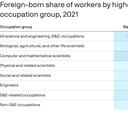Foreign-born STEM talent remains key to U.S. research

Advances in critical areas of science and tech in the U.S. hinge on foreign-born scientists and engineers, according to a key report on science and engineering competitiveness published today.
Why it matters: The U.S. isn't the only option for the world's top scientists and engineers. Global competition around AI, computing, biotech and materials science is intensifying as other countries invest heavily in science and engineering research, infrastructure and talent.
- "Our dependence on foreign talent, especially from strategic competitors like China and India, has been a double-edged sword — propelling us forward but also exposing critical vulnerabilities," says Divyansh Kaushik of the Federation of American Scientists.
- The National Science Board is calling for increased investment to grow the country's domestic science and engineering workforce. NSB advises Congress and the White House on science and engineering research and education policy and publishes a congressionally mandated report on the state of U.S. science and engineering every two years.
By the numbers: There were 36.8 million people in STEM occupations in the U.S. in 2021 — about 24% of the country's total workforce. That's about a 2% increase since 2011, according to the report, which is prepared by the National Science Foundation's National Center for Science and Engineering Statistics.
- Foreign-born workers accounted for 19% of all U.S. STEM workers and 43% of scientists and engineers with doctorate degrees in 2021, the latest year of data in the report.
- About 58% of doctorate-level computer and mathematical scientists in the country's workforce — who drive the development of artificial intelligence, computing and other technologies deemed critical by the U.S. government — were born outside the U.S., according to the report.
- India (29%) and China (12%) were the top places of birth for foreign-born science and engineering workers in the U.S.
Zoom in: More than one-third of science and engineering doctorate recipients in the U.S. between 2018 and 2021 held temporary visas. Nearly three-quarters of these recipients, who were largely from China and India, intended to stay in the U.S. for at least one year.
- About 88% of recipients with Chinese citizenship said they intended to stay for 5 years and 81% said for 10 years.
Yes, but: Data from China indicates students are increasingly returning home. The ratio of students returning to China to those going abroad to study around the world climbed from about 0.5 in 2010 to just over 0.8 in 2019.
What they're saying: The NSB is calling for the U.S. to invest more heavily in training domestic STEM workers, but "foreign-born talent has been, and remains, key to U.S. strength in STEM," a NSB policy brief on the report says.
- NSB emphasizes expanding the international science and engineering talent pool by attracting students from "emerging science partner countries — low-and middle-income countries building their R&D enterprises that are poised to become the collaborators of tomorrow," the brief says.
- These include Bangladesh, Iran and Nepal, which are among the countries with the most students studying in the U.S.
- The U.S. response should be "multifaceted, striking a balance between attracting the world's brightest minds and cultivating a homegrown pool of talent capable of leading the next wave of innovation," Kaushik says.
The big picture: The U.S. is still home to some of the world's top universities, which attract students from around the world, and outspent other countries on R&D in 2021.
- But indicators are piling up that China and other countries in East and Southeast Asia are chipping away at the decided edge the U.S. enjoyed for decades.
- The number of international patents filed from inventors in China surpassed applications from the U.S. in 2021.
- In 2019, China for the first time awarded more doctorate degrees in science and engineering than the U.S.